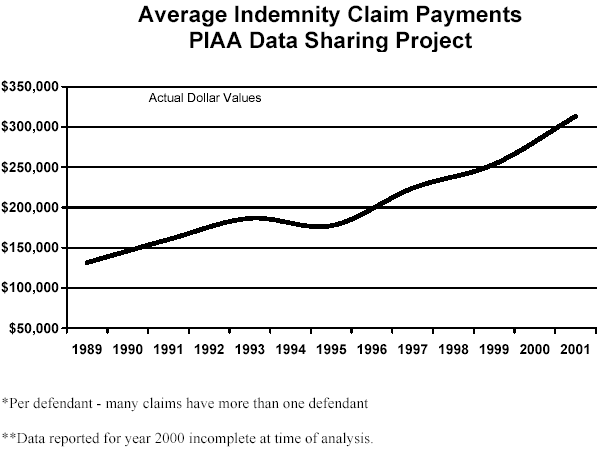Presented by Richard E. Anderson, MD, FACP, Chairman of The Doctors Company, for the Physician Insurers Association of America Before the Subcommittee on Health of The House Committee on Energy and Commerce, U.S. House of Representatives
Wednesday, July 17, 2002
Chairman Bilirakis, Representative Brown, and members of the subcommittee, thank you for this opportunity to present to you today our views on the implications of excessive litigation and the need for federal healthcare litigation reform. My name is Richard Anderson, and I am an oncologist with more than 25 years’ experience practicing cancer medicine in California. I am also chairman of The Doctors Company, one of the 45 doctor-owned and/or operated medical liability insurers that comprise the Physician Insurers Association of America (PIAA). Collectively, the PIAA companies insure over 60 percent of the nation’s practicing physicians, more than 277,000 doctors and 1,100 hospitals. On behalf of our member companies and their insureds, the PIAA has always supported healthcare liability reform that more equitably and rapidly compensates patients who have received substandard care, but which at the same time limits frivolous lawsuits and increases access to healthcare.
Background
Despite stunning advances in scientific knowledge, medicine remains more art than science, because human beings are not machines. Sadly, however, the tide of litigation against America’s doctors rises ever faster. Approximately one of every six practicing physicians faces a malpractice claim every year. In high-risk specialties such as obstetrics, orthopedics, trauma surgery, and neurosurgery, there is one claim for each doctor every two and one-half years. Fully 70 percent of these tens of thousands of cases are found to be without merit. Nonetheless, each one requires a costly legal defense. Nationally, as the chart below shows, these loss adjustment expenses average $22,967 per defendant. Cases that go all the way through trial before a vindicating defense verdict average $85,718 per defendant.1[See chart below] The Doctors Company alone has spent more than $400 million defending claims that ultimately were shown to be without merit.
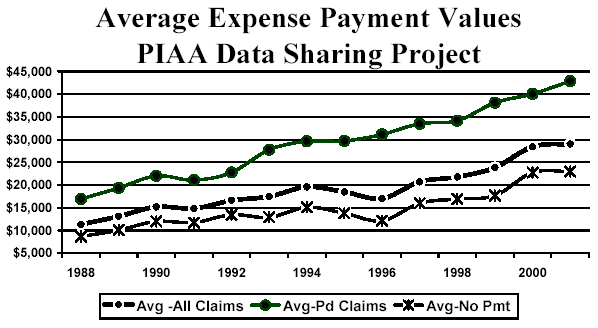
Roots of the Current Environment
Medical liability claims were fairly uncommon until the 1970s. Nearly 80 percent of the malpractice claims in the 20th century to date were filed between 1970 and 1975.2Massive losses forced many commercial insurers to conclude that the practice of medicine was an uninsurable risk, and they simply refused to provide malpractice insurance at any price. This resulted in a “crisis of availability” to which providers responded emergently. Doctors contributed their own funds as capital to support the efforts of their state medical and hospital associations, among others, to start as many as 100 provider-owned specialty carriers across the country. Dubbed “bed pan mutuals” by their commercial competitors (many of whom had fled the market), these upstarts were not expected to succeed where the giant commercials could not find success. Because their primary mission is to provide a service, and because they were entirely committed to remaining present even in the most difficult markets, these companies have succeeded and are the basis of the PIAA. As one example, The Doctors Company was formed by doctors, for doctors, in 1976 and today insures more than 25,000 doctors throughout the nation.
A Litigious Society Grows
A second crisis emerged in the early 1980s, known as a “crisis of affordability.” Insurers faced ever-mounting losses, with rampant increases in paid claim frequency (number of paid claims) and severity (amount of indemnity payment). PIAA data shows that, on average, it takes five and one-half years for an insurer to close a malpractice claim after the date of the incident.3There is often a long lag before the claim is reported. The majority of the delay, however, comes because of the inefficiencies of the tort system. In contrast, California’s Medical Injury Compensation Reform Act of 1975 (MICRA) largely eliminates the lottery aspect of malpractice litigation, and The Doctors Company data reveals that claims are settled in one- third less time than the national average. This not only decreases the cost of litigation, but it means injured patients are indemnified faster in California.
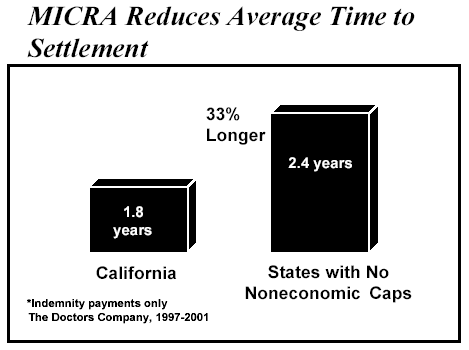
During much of the 1990s, PIAA companies exercised appropriate fiduciary responsibility and wisely invested the premium deposits of their policyholders. The significant returns were used, not to line the pockets of the companies, but to subsidize premium rates being charged to policyholders. This allowed them to remain affordable even as claims costs were increasing. It was the policyholders (healthcare providers) who reaped the financial benefits.
It must be noted that insurance is a highly regulated industry. Every state department of insurance, as well as the national rating agencies, closely monitors both the kinds and qualities of investments. Virtually no medical liability insurance company has experienced capital losses in excess of investment income. In fact, 80 percent of investments by PIAA companies are in high-grade bonds. What has happened is that investment yields have declined as interest rates have fallen and can no longer subsidize premium rates to the extent they once did. In other words, premium rates must now more closely match the actual cost of losses. The combination of these factors created “the perfect storm” for medical liability insurers.
The Perfect Storm
During this same time period, claim frequency and severity continued to increase. In addition, reinsurance costs rose significantly in relation to the increase in loss costs. The insurance system was able to accommodate even this inexcusable volume of litigation as long as the size of the few valid claims was predictable. Unfortunately, in the past few years, there has been an explosion in the cost of individual claims. Texas has seen a $268 million verdict. A number of states have witnessed verdicts in excess of $100 million. The city of Philadelphia alone has recorded multiple verdicts in excess of $50 million in just the past two years. Four claims in Arkansas totaled $98 million in just the past year. According to PIAA data [shown on next chart], during the period 1991 to 2001, the percentage of claims costing in excess of $1 million dollars increased nearly four-fold. Insurance is not magic. If society expects insurers to pay unlimited awards, it should expect unlimited premiums. As premiums increase, so must the cost of healthcare. Since healthcare today is a zero-sum game, these cost increases mean corresponding decreases in access to healthcare.
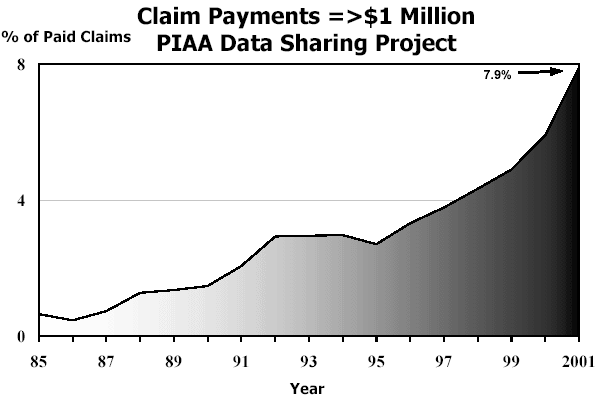
Those are the largest claims. What about the size of the average claim? PIAA data shows that the average indemnity payment in 2001 was more than $310,000, a 60 percent increase in the last five years. As the next chart shows, the cost of the average malpractice payment is rising precipitously. In New York and Pennsylvania alone, nearly $1 billion was paid in 2000.
The Current Situation
As the new millennium began, insurers who were not able to weather the storm experienced rapidly deteriorating financial results. Expressed differently, a number of companies that believed they could provide insurance for less than its true cost learned the inevitable lesson. Several, such as PHICO, PIE, and Reliance, have ceased all underwriting operations. In December of last year, long-time industry leader St. Paul announced that due to unsustainable losses and the “unfavorable tort environment,” the company would no longer write new medical liability coverage, and that it would not renew the policies of its 42,000 physicians, 750 hospitals, and 73,000 other healthcare providers. Though St. Paul is a commercial carrier and not a member of PIAA, it is telling that the largest company in the industry for the better part of two decades feels that it can no longer afford the risk of insuring the practice of medicine. Companies remaining in the market have had no choice but to take the rate increases necessary to insure survival. Conning & Co. estimates that malpractice insurers will pay out approximately $1.40 for every premium dollar collected in 2001 and 2002. Even with the projected rate increases, Conning & Co. still projects insurers will pay out $1.35 for each dollar collected in 2003 (Conning Report on Medical Malpractice Insurance, April 2002). PIAA data reveals that since 1990, claims costs have increased by 6.9 percent annually, nearly three times the rate of inflation.
False Allegations
The average claim payment has increased by 60 percent over the past five years. The cost of the most expensive claims has exploded in a manner that is absolutely unprecedented. If judgments are to be unlimited, the premiums needed to pay for those judgments must increase accordingly. With absolute certainty, this money will be taken out of our healthcare system and compound the severe access to care issues that we face today.
Several spurious arguments have been put forth by those with an interest in continuing the tsunami of medical malpractice litigation. First, it has been deceptively argued that stock market losses are the real driver of price increases. In fact, investments by insurance companies are highly regulated and controlled by each state department of insurance and closely monitored by the rating agencies. Insurance companies continue to gain funds from their investments and use those funds to offset higher malpractice premium rates. As income from investments decreases, however, premiums must more closely match losses.
Second, it is argued that insurance companies should have raised rates sooner. There may be some truth to this. However, it is difficult to understand how having today’s sky-high rates earlier would make them more palatable.
Third, it is argued that insurance companies fail to settle claims when they should and are, therefore, exposed to astronomic jury verdicts. This is a particularly empty argument. In most cases, it is the physician, not the company, who must make any settlement decision. Doctors are found to be without fault in approximately eight out of 10 malpractice trials. Should these cases have been settled? Moreover, it is difficult to accept the notion that the price for demanding one’s day in court should be an unreasonable jury verdict.
Finally, there are those who argue for a state-run medical liability system. Allow me to point out that the majority of state-run malpractice programs have gone bankrupt or charge premiums that are much higher than those charged by PIAA companies. In New York, premiums are actually set by the Department of Insurance, not by individual companies, and New York rates are among the highest in the nation.
There Is a Proven Solution
California has 27 years of experience with the MICRA statutes. We know, we do not have to speculate, that tort reform works. Since 1975, The Doctors Company malpractice premium rates in California have decreased by 40 percent in constant dollars. [See chart below] This is true despite the fact that there has not been, and is not today, any limit on actual damages awarded.
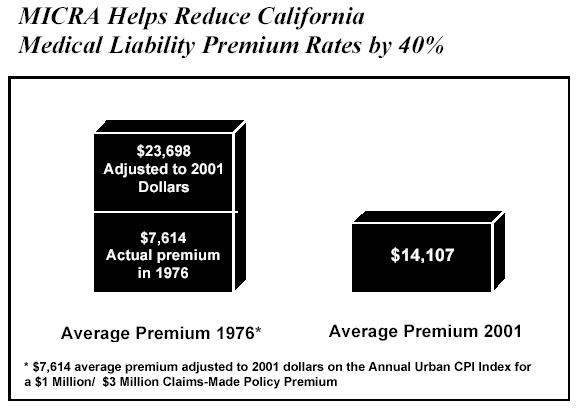
We know, we do not speculate, that claims settle about 33 percent faster in California than the rest of the nation because the lottery aspect of noneconomic damages has been controlled. We know, we do not speculate, that even very large judgments can be accommodated by the insurance system because they can be paid on an annual basis over the intended period of compensation, not as a single jackpot.
We know, we do not speculate, that injured patients actually take home a significantly higher percentage of awards in California because there is an upper limit on attorney contingency fees. In many areas, more than 40 percent of a malpractice award goes directly into the pocket of the plaintiff’s attorney. In California, MICRA contains a limitation on this fee. An attorney winning a $1 million claim must be satisfied with a legal fee of $221,000.
We know, we do not speculate, that MICRA has not limited access to attorneys. California remains a litigious state, and The Doctors Company data shows the frequency of malpractice cases in the state is 50 percent higher than the national average.
California has passed effective tort reforms, and its providers have been able to weather this liability crisis very well. These same reforms are found in H.R. 4600, the Help Efficient, Accessible, Low-Cost, and Timely Healthcare Act of 2002 (the HEALTH Act). The PIAA and The Doctors Company fully support the provisions of this act, which when signed into law, will provide the same protections to patients across the United States as found in California for over a quarter century. The next chart, which was compiled from data reported to the National Association of Insurance Commissioners, clearly demonstrates the effectiveness of MICRA.

We thank members of the Committee and their staff for holding this important hearing and inviting us to testify. We look forward to working with you to make the healthcare liability system fairer for everyone. I will be happy to answer any questions.

